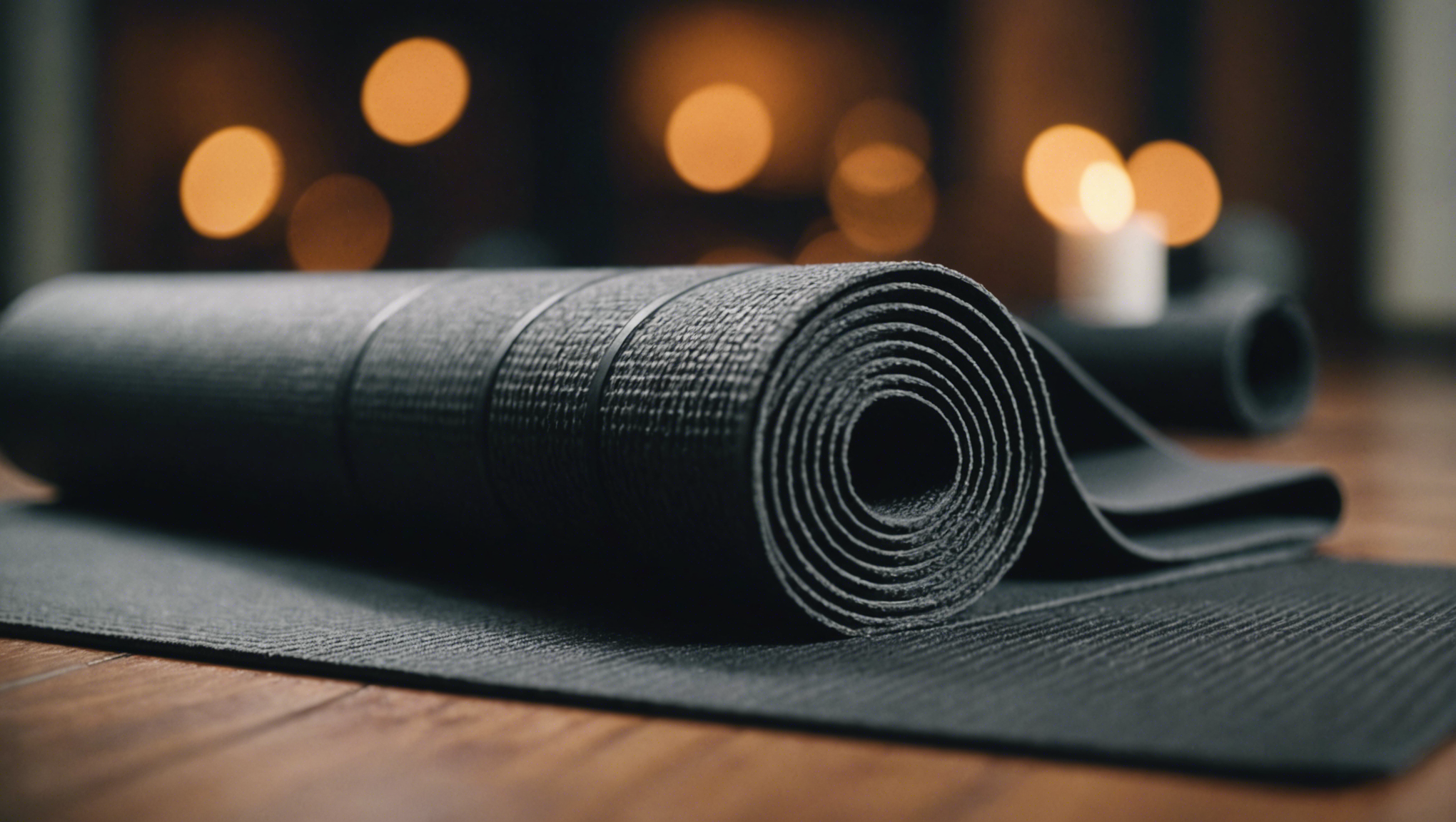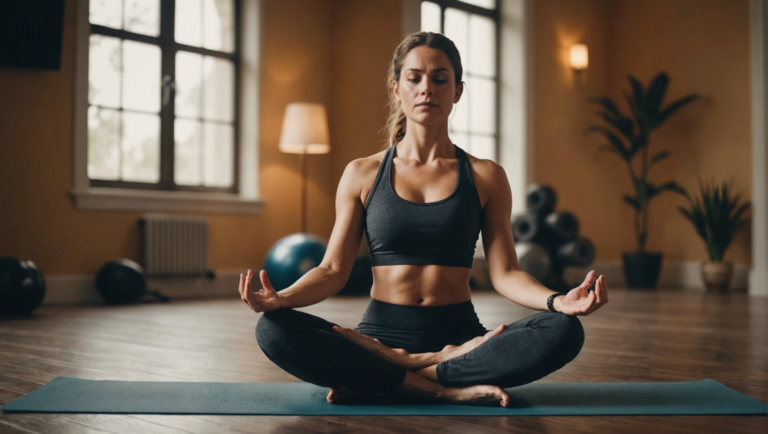Are Yoga Mats Toxic? Unveiling The Truth
The Hidden Dangers of Yoga Mats: Unveiling What Lurks Beneath
The Toxic Truth Behind Yoga Mats
Yoga, a centuries-old practice known for enhancing physical, mental, and spiritual well-being, often involves a simple piece of equipment: the yoga mat. However, beneath the surface of these colorful and seemingly innocuous mats may lie hidden dangers to our health and environment. This revelation prompts us to delve deeper into what exactly makes some yoga mats a concern and how we can make safer choices.
The Composition of Yoga Mats and Associated Risks
Many yoga mats are made from polyvinyl chloride (PVC), a popular material for its durability and grip. However, PVC is a plastic that contains phthalates, chemicals used to make plastics more flexible, which have been linked to various health issues, including hormonal disruptions, reproductive problems, and even certain types of cancers. The production and disposal of PVC mats also pose significant environmental hazards, releasing toxic chemicals into the atmosphere and contributing to the accumulation of non-biodegradable waste.
Alternative Materials Offering Safer Options
Recognizing the need for safer alternatives, manufacturers have begun to produce yoga mats made from natural rubber, jute, and organic cotton. These materials promise to minimize the health and environmental risks associated with PVC mats. Natural rubber, while providing a similar level of durability and grip, is biodegradable and free from toxic chemicals. Jute and organic cotton mats offer sustainable options, further reducing the ecological footprint of our yoga practice.
Certification and Standards for Non-Toxic Mats
When searching for a non-toxic yoga mat, certifications become a beacon of trust and assurance. Certifications such as OEKO-TEX Standard 100, eco-INSTITUT, and GOLS (Global Organic Latex Standard) indicate that a product has been tested and meets specific safety standards. These certifications help consumers identify yoga mats that are free from harmful chemicals, ensuring a safer yoga experience.
The Importance of Proper Mat Care
Even with a non-toxic mat, proper care is essential to maintain its integrity and minimize any potential risks. Regular cleaning, avoiding prolonged sun exposure, and proper storage all contribute to the longevity and safety of your yoga mat. Natural materials, in particular, may require more attentive care to preserve their biodegradable qualities while preventing mold and mildew.
Making Informed Decisions for a Safer Practice
The quest for a safe yoga practice extends beyond the choice of mat. It encompasses an awareness of the materials we interact with and their impact on our health and the environment. By opting for yoga mats made from natural, sustainable materials and adhering to rigorous safety standards, we not only protect ourselves but also contribute to a healthier planet. The journey towards a safer yoga experience begins with informed decisions, emphasizing the importance of research and mindfulness in our choices.
The Road Ahead: Innovations in Yoga Mat Technology
Innovation in yoga mat technology presents a promising outlook for combining safety with performance. Companies are exploring new materials that offer the grip and durability of PVC without the associated health risks. These advancements, coupled with a growing consumer demand for eco-friendly products, suggest a future where yoga mats support our well-being in every sense.
Yoga mats are more than just a tool for practice; they are a symbol of the yogic commitment to harmony with oneself and the environment. As we unravel the hidden dangers of conventional yoga mats, we uncover opportunities to align our choices with these values. The path to a safer, more conscious yoga practice is paved with knowledge, and by choosing non-toxic, eco-friendly yoga mats, we embrace a holistic approach to wellness that honors both our health and the planet’s.
Decoding the Materials: What Are Most Yoga Mats Made Of?
Yoga, an age-old practice for the mind, body, and spirit, has seen a meteoric rise in popularity worldwide, bringing into focus the tools of the trade, notably yoga mats. The quest for the perfect yoga mat often leads enthusiasts to ponder the materials that compose these essential fitness companions. Understanding what yoga mats are made of is crucial not just for ensuring the mat aligns with personal ethical and health standards but also for optimizing the practice itself.
Unraveling the Mystery: Primary Yoga Mat Materials
The core component of most yoga mats is the material from which they are made. This material not only defines the mat’s tactile feel and performance but also its environmental impact. Traditionally, yoga mats were crafted from natural materials, such as cotton or jute, offering a sustainable yet less durable option. Today, the array of materials has expanded vastly to include both natural and synthetic options, each with its unique set of characteristics.
The Traditional Choice: Natural Rubber
Natural rubber, tapped from rubber trees, presents an eco-friendly option that doesn’t skimp on performance. Known for its excellent grip and cushioning, natural rubber mats cater to those seeking a product that is both kind to the planet and beneficial for their practice. However, it’s essential for users with latex allergies to steer clear of natural rubber mats due to potential allergic reactions.
The Modern Marvel: PVC and TPE
PVC, or polyvinyl chloride, stands out as the most common material in yoga mat production due to its durability, affordability, and ease of cleaning. While PVC mats excel in providing a stable, sticky surface ideal for yoga practices, they are not biodegradable, raising concerns about their environmental footprint.
In response to growing sustainability concerns, thermoplastic elastomer (TPE) mats have emerged as a more eco-friendly synthetic alternative. TPE, a blend of plastic and rubber, offers the resilience and comfort of PVC with the added benefit of being recyclable and less harmful to the environment.
Going Green: Eco-Conscious Choices
As awareness about environmental issues grows, so does the demand for yoga mats made from sustainable materials. Mats made from recycled materials, cork, and organic cotton offer environmentally conscious yogis options that do not compromise on quality or performance. Cork mats, in particular, are celebrated for their natural resistance to bacteria and excellent grip, even when wet.
Why Material Matters
The choice of yoga mat material impacts more than just the environment; it also affects the user’s health, practice, and the mat’s lifespan. For instance, mats made from natural materials tend to be more breathable but may require more frequent replacement than their synthetic counterparts. On the other hand, synthetic materials offer longevity and superior grip but may include chemicals of concern for those mindful of toxins.
Balancing Needs with Ethics
Choosing the right yoga mat material is a balancing act between personal needs, ethical considerations, and environmental impact. For those prioritizing sustainability, natural rubber, cork, and jute represent viable options. Meanwhile, practitioners seeking the utmost in durability and performance might lean towards PVC or TPE mats, with an eye on the newer, more eco-friendly variations of these materials.
The Path Forward
The evolution of yoga mat materials reflects a broader trend towards sustainability and environmental consciousness in the fitness industry. As manufacturers innovate to create materials that are both high-performing and kind to the planet, yogis are empowered to make choices that align with their values and practices. Whether opting for the natural simplicity of cotton or the advanced engineering of TPE, the key lies in selecting a mat that supports one’s yoga journey in a holistic sense—mind, body, and spirit.
Selecting the right yoga mat material is not merely a matter of personal preference but an opportunity to contribute positively to the planet while pursuing a path of wellness. As the landscape of yoga mat materials continues to expand and evolve, yogis have an unprecedented chance to tailor their practice to their ethical beliefs and environmental values, bridging the gap between ancient tradition and modern sustainability.
Health Implications: How Toxic Yoga Mats Affect You
When the serenity and focus of your yoga practice are paramount, the last thing you’d want is to find out that your yoga mat might be impacting your health negatively. With the global wellness industry booming, and yoga being a fundamental aspect of this growth, the materials used in yoga mats have come under scrutiny. Here’s a deep dive into the health implications associated with toxic elements found in some yoga mats, shedding light on the importance of choosing your yoga gear wisely.
Unraveling the Mystique Around Yoga Mat Composition
The common perception is that a yoga mat is just a simple, inert platform for exercise and meditation. However, the truth is far more complex. Many conventional yoga mats are made from Polyvinyl Chloride (PVC), a popular plastic known for its durability and ease of manufacture. PVC is also infamous for containing toxic chemicals, including phthalates, lead, cadmium, and a cocktail of other substances linked to various health issues.
Phthalates: The Hidden Hazards
Phthalates, mainly used as plasticizers in PVC, are of particular concern. These chemicals have been associated with a range of endocrine-disrupting effects, potentially impacting reproductive health, fetal development, and increasing the risk of obesity and insulin resistance. The disturbing aspect is that phthalates can leach, vaporize, and enter the human body through inhalation, ingestion, or skin contact, raising significant concerns for regular yoga practitioners.
Beyond Phthalates: Other Toxic Intruders
Phthalates are not the only worry. Heavy metals like lead and cadmium, found in some lesser-quality mats to add color or as stabilizers, can have neurotoxic effects, especially harmful to children and pregnant women. Also, the manufacturing process of PVC mats releases dioxins, highly toxic compounds that can persist in the environment and accumulate in the food chain, leading to long-term exposure risks.
Navigating Toward Safer Alternatives
Fortunately, as awareness grows, so does the availability of safer, more sustainable yoga mat options. Natural rubber, jute, and organic cotton mats are becoming increasingly popular, offering similar durability and grip without the adverse health impacts associated with PVC mats. These materials are not only safer for individuals but also for the environment, aligning with the ethos of yoga itself.
The Health-Conscious Choice
When selecting a yoga mat, consider not just the immediate comfort and grip it provides but also the long-term health implications. Look for mats certified free from toxic chemicals and heavy metals. Many reputable companies disclose their materials and manufacturing processes, providing peace of mind to health-conscious yogis.
Empowering Your Practice with Knowledge
Knowledge is power, especially when it comes to protecting your health in all aspects of life, including yoga. By choosing non-toxic, eco-friendly yoga mats, you’re not only safeguarding your well-being but also contributing to a healthier planet. As the yoga community continues to embrace sustainability and health, let your practice be an extension of these values.
Final Thoughts
The journey toward health and wellness is multifaceted, encompassing not only the physical practices we engage in but also the tools and accessories we use. In the realm of yoga, where harmony and health are central tenets, the choice of a yoga mat can have unforeseen health implications due to the presence of toxic chemicals in common materials like PVC. Awareness and informed decisions can steer practitioners towards safer alternatives, ensuring that their practice remains a true sanctuary for both the body and the environment. As yoga continues to evolve as a pillar of holistic health, let the integrity of our choices reflect the depth of our commitment to well-being.
The Shift Towards Sustainability: Exploring Eco-Friendly Yoga Mat Options
The burgeoning awareness and commitment towards environmental preservation have inspired a profound transformation within the realm of yoga practice. This transformation is not just limited to the philosophies and ethics that guide yoga principles but has extensively permeated the choice of accessories used, notably yoga mats. Traditionally, yoga mats have been crafted from materials that raise concerns regarding sustainability and environmental impact. However, the paradigm is swiftly shifting towards eco-friendly options, reflecting a broader commitment to sustainability.
Exploring the Composition of Conventional Yoga Mats
Conventionally, most yoga mats have been made from polyvinyl chloride (PVC), a type of plastic notorious for its negative environmental impact. PVC production and disposal introduce harmful chemicals into the ecosystem, contributing to pollution and posing health risks to humans and wildlife alike. Recognizing these concerns, yogis and manufacturers alike are turning their focus towards more sustainable materials that align with the ethos of yoga—a practice deeply rooted in harmony and respect for all living beings.
The Rise of Eco-Friendly Yoga Mat Alternatives
The quest for sustainable yoga practice accessories has led to the emergence of a variety of eco-friendly yoga mat options. These alternatives prioritize biodegradability, non-toxic production processes, and the use of renewable resources. Among the most popular eco-conscious materials are natural rubber, cork, jute, and organic cotton.
Natural rubber, derived from the sap of rubber trees, offers a renewable and biodegradable solution, minimizing environmental impact. Cork mats, celebrated for their durability and natural antimicrobial properties, provide a sustainable choice that does not harm the cork oak tree. Jute and organic cotton mats further expand the options for eco-conscious yogis, offering plant-based alternatives that are both sustainable and supportive of ethical farming practices.
Benefits Beyond Sustainability
The shift towards eco-friendly yoga mats is not solely motivated by environmental considerations. These sustainable alternatives offer distinct benefits that enhance the yoga practice. Natural rubber mats, for example, are known for their superior grip and cushioning, supporting a safe and stable practice. Cork mats similarly offer excellent traction, becoming even grippier when wet, making them ideal for hot yoga sessions.
Moreover, eco-friendly mats often avoid the use of toxic chemicals and dyes, contributing to a healthier practice environment that aligns with the holistic health goals of yoga. The natural materials used also lend these mats a unique aesthetic and tactile quality, enriching the sensory experience of yoga practice.
Embracing Sustainability in Yoga Practice
Adopting eco-friendly yoga mats represents a meaningful step towards a more sustainable yoga practice—a reflection of the principle of Ahimsa or non-harming, central to yogic philosophy. This shift not only reduces the environmental footprint of yoga practice but also promotes a deeper connection with nature, enhancing the spiritual and ethical dimensions of yoga.
Yogis making the transition to eco-friendly mats are encouraged to consider the lifecycle of their purchase, from production and use to disposal. Opting for mats made by companies committed to ethical practices, including fair labor conditions and minimal environmental impact, further aligns with the values of conscious consumption and responsibility towards the planet.
The Future of Yoga Practice: Sustainable and Mindful
The movement towards eco-friendly yoga mats is indicative of a broader trend within the yoga community towards sustainability and ethical living. As awareness grows and more individuals seek to align their practice with their environmental values, the demand for sustainable yoga accessories is likely to continue rising. This growing demand encourages innovation and competition among manufacturers, leading to the development of even more sustainable, high-quality yoga products.
In embracing eco-friendly yoga mat options, yogis contribute to a virtuous cycle of sustainability that benefits not only the environment but also enriches their own practice. By choosing materials that honor the earth, practitioners weave the principles of mindfulness, respect, and interconnectedness more deeply into the fabric of their daily lives, embodying the true essence of yoga.
Care and Maintenance: Prolonging the Life of Your Yoga Mat Safely
Ensuring the Longevity of Your Practice Companion
Regular Cleaning is Key
The foundation of prolonging the life of a yoga mat begins with routine cleaning. Sweat, oils, and dirt can degrade the material of the mat over time, not to mention harboring bacteria that could lead to unpleasant odors or skin irritations. A simple solution of water and gentle soap, applied with a soft cloth, can work wonders. For those looking for a more natural approach, a mixture of water and white vinegar can also provide an effective clean. It’s essential to avoid harsh chemicals which may break down the mat’s material faster than normal wear and tear would.
Dry Thoroughly After Washing
After cleaning, drying your yoga mat properly is just as important as the wash itself. Rolling up a wet or damp mat can promote fungal and bacterial growth, leading to the issues you’re trying to avoid by cleaning it in the first place. The best drying method is to air-dry the mat flat, away from direct sunlight to prevent fading and breakdown of the materials. If you need to speed up the drying process, patting the mat down with a towel to absorb excess moisture before air-drying can help.
Store Appropriately
How and where you store your yoga mat can greatly impact its longevity. Avoid keeping it in extreme conditions such as in a hot car or in a damp, cool area. These environments can cause the mat to deteriorate quicker. Ideally, the mat should be stored in a cool, dry place, rolled or folded neatly. Ensuring the mat is dry before storage is crucial to prevent any mold or mildew from forming. For those who use their mats frequently, investing in a breathable mat bag can offer convenience while allowing the mat to air out between uses.
Mindful Use and Handling
The way you use your yoga mat can also affect its lifespan. Wearing yoga-specific or clean footwear (or practicing barefoot) can reduce the amount of dirt and grit that comes into contact with your mat. It’s also beneficial to rotate your mat from one class to another, ensuring even wear and tear. Be mindful of jewelry or other accessories that could potentially scratch or puncture the mat during practice.
Periodic Deep Cleaning
Aside from regular cleaning, giving your yoga mat a deeper clean every few months can help extend its life even further. This can involve a more thorough scrubbing with a soft brush to get rid of accumulated dirt within textures or a soak in a bathtub for a very gentle, deep clean, followed by a thorough rinse. Remember, the goal is to freshen up the mat without compromising its integrity with aggressive cleaning methods.
Invest in a Quality Mat
Investing in a high-quality mat can make a significant difference in its lifespan. While the initial cost might be higher, premium mats often offer better durability, materials that are more resistant to wear and tear, and superior grip and comfort. Additionally, many high-quality mats come with warranties or guarantees, adding an extra layer of protection for your investment.
Ensuring the longevity of your yoga mat requires a combination of regular cleaning, proper drying, careful storage, and mindful use. By following these steps, you not only extend the life of your mat but also maintain a hygienic and pleasant practice environment. Remember, your yoga mat is your partner in your journey of mindfulness and wellness, deserving of care and respect to support your practice for years to come.
Conclusion
The journey through the complex world of yoga mats, from uncovering their hidden dangers to exploring eco-friendly alternatives, invites a reflective pause on what lies beneath our feet during our practice. This exploration reveals not just a tale of caution but also a narrative of empowerment, guiding us towards informed choices that enhance our health and honor our planet.
Delving into the hidden dangers of yoga mats, we unmasked the reality that not all mats serve our wellness or the environment with equal fidelity. The common materials many yoga mats are constructed from, including PVC and other synthetic compounds, can harbor harmful chemicals. These materials, favored for their durability and grip, unfortunately, come with a cost to both individual health and environmental integrity. This revelation prompts a closer examination of what we introduce into our sacred spaces of mindfulness and physical wellness.
The impact of toxic yoga mats on health cannot be overstated. As practitioners embrace the physical and mental discipline of yoga, they seek not only to improve their well-being but also to nurture a deeper connection with their surroundings. The very tools designed to support this journey may, paradoxically, introduce risks. Chemicals such as phthalates and other volatile organic compounds (VOCs), found in many traditional yoga mats, have been linked to a range of health issues, including hormonal disruptions and respiratory problems. This underscores the importance of not just what practices we bring into our lives, but what products we choose to support those practices.
However, the narrative does not end on a note of caution. The shift towards sustainability within the yoga community illuminates a path forward, marked by innovation and intention. Eco-friendly yoga mat options, crafted from natural materials like organic cotton, jute, and natural rubber, offer a promising alternative. These materials not only mitigate the health risks associated with their synthetic predecessors but also embody a commitment to environmental stewardship. The rise of these sustainable options reflects a broader awakening to the interconnection between personal wellness and planetary health.
Yet, the shift towards more sustainable practices extends beyond the initial selection of an eco-friendly yoga mat. The care and maintenance of yoga mats play a crucial role in this holistic approach to wellness and environmental responsibility. Proper cleaning methods and regular maintenance ensure that eco-friendly mats remain functional and hygienic over time. This attention to care extends the lifespan of yoga mats, reducing waste and further emphasizing the value of choosing products that align with both personal health and ecological balance.
As we stand on our mats, poised between the earth below and the sky above, we are reminded of the choices that shape our practice and our world. The journey through the complexities of yoga mat selection is more than a quest for a non-toxic foundation for our asanas. It is a reflection of our broader values and aspirations.
Choosing a yoga mat becomes a symbolic act, one that reflects our commitment to wellness, awareness, and ecological sensitivity. This journey invites us to consider not just the immediate comfort and support of our yoga practice, but the broader impact of our choices on our health and the health of our planet.
In the realm of yoga, where the integration of body, mind, and spirit is paramount, the tools we choose to support our practice carry profound significance. As practitioners, our mat is our partner, supporting each posture and breath. Let it then be a partner that not only upholds us physically but also aligns with our deepest values of health, sustainability, and mindfulness.
The narrative that unfolds from beneath our feet tells a story of awareness, choice, and transformation. It invites us to tread lightly and thoughtfully, embracing the power of informed choices in nurturing our well-being and that of the world around us. In this journey toward healthier, more sustainable yoga practices, we find not just better yoga mats, but also a deeper connection to the essence of yoga itself: a harmonious balance between self-awareness and universal consciousness.



